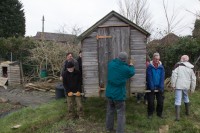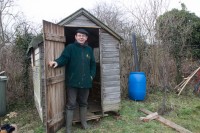The great flitting
In the 1770’s when the New Town was built to the north of the Old Town in Edinburgh, there was a mass movement of people from Old to New – abandoning the insanitary courtyards and tenements of the medieval city for the glories of the new Georgian squares and circuses. It was known as ‘the great flitting’. It is hardly on the same scale, but this weekend saw my great flitting. After 28 years on my allotment plot I moved. Call it downsizing, call it pragmatism, even the effects of getting older perhaps. But having a garden, an allotment down to fruit trees, and another for vegetables, as well as a share of a poly tunnel, was beginning to feel like too much. After all, daughters flew the nest some yeas ago, partner Sue has her own allotment in Bristol, which I also loyally help with, and the plan is to spend more time growing veg in the garden. So that veg plot was beginning to look like outdoor housework – or at best, a way of growing far more than I could possibly consume, and then wondering why I did it after giving three quarters of it away (pleasurable thought that can be). Decision made last autumn, to consolidate on just one plot – the orchard.
Making the move will take time. The orchard is mass of trees (!) and a lot of grass between them. A couple of years ago the City Council, after pressure from plot holders because of repeated flooding of the site, spent time laying drainage pipes (see my blogs on the susceptibility of my old plot to flooding, and the councils work on the orchard one). They go right across my orchard plot and in doing so took out most of the hedge. So now there is much more space; space where the hedge was and space opened up between the trees, space to dig and turn into a series of mini plots, just right for the fugitive veg. Digging out the remaining hedge roots, the ivy all over the ground, and prepping up new beds is the really time consuming bit, but progress is being made. The symbolic moment to is that move of tools and equipment from one plot to the other – and the shed to put them all in.
In the USA there is a tradition of the whole village turning out to assist in the local farmers ‘barn raising’. A couple of blokes can never do it on their own, it is a communal effort, with much merrymaking at the end of a hard days work, and a farming family standing proudly in front of their new barn. Here its much the same if on a smaller scale. So come Saturday, the allotment association work party gathered, the shed assessed, carrying poles rustled up and the work began.The shed is over 40 years old. They made ’em different in them days. None of this flimsy planking held together with glorified staples. This shed is solid – it has survived several moves since I acquired it, second hand, in 1980. So first reactions of the ‘Oh, I think we can manage this with four’, one person at each corner, soon proved wide of the mark.
 In the end it was eleven; six on the three steel poles, two more front and back, and one out front (not me) issuing instructions and clearing a safe path. All in all it took about 30 minutes to move first the base and then the superstructure and put the back together 300 metres away on the new plot. Incredibly the shed was so sturdy and the move so careful, that when the superstructure was gently laid back on the base, the screw holes for the metal brackets slotted straight back. It could all be screwed back together using the same screws. Result: barn raising allotment-style achieved.
In the end it was eleven; six on the three steel poles, two more front and back, and one out front (not me) issuing instructions and clearing a safe path. All in all it took about 30 minutes to move first the base and then the superstructure and put the back together 300 metres away on the new plot. Incredibly the shed was so sturdy and the move so careful, that when the superstructure was gently laid back on the base, the screw holes for the metal brackets slotted straight back. It could all be screwed back together using the same screws. Result: barn raising allotment-style achieved.  Thanks friends and fellow plot holders. Come a summer evening, the drinks are on me.
Thanks friends and fellow plot holders. Come a summer evening, the drinks are on me.

